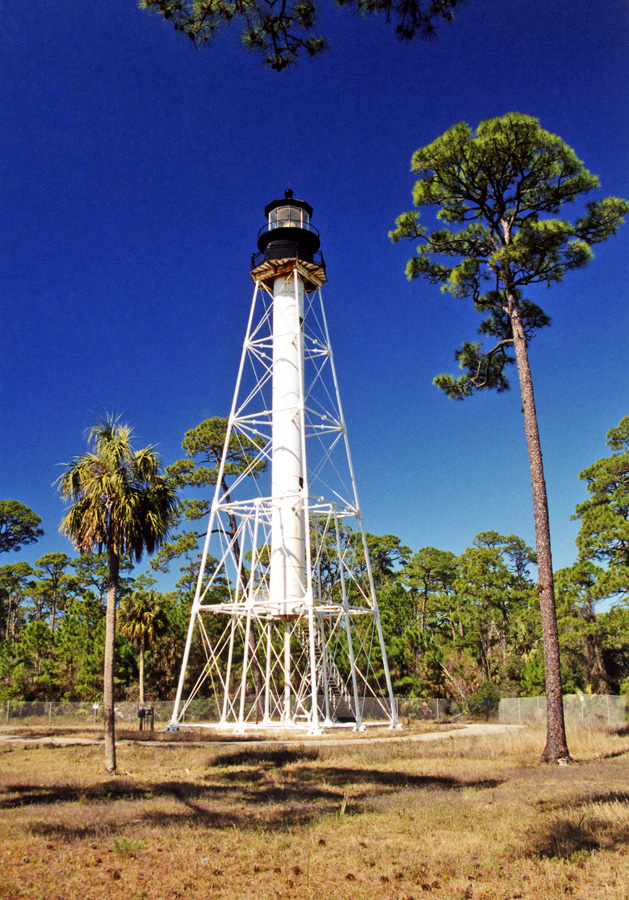What's this I see coming down the road in PSJ? Oh, its only a lighthouse and a couple of historic homes!
It is not every day that you see a lighthouse and it's
associated dwellings being moved. In fact, I believe that only 3 such
structures have been physically relocated in the United States. I know the
first to be moved was the Cape Hatteras light, as I had a very small
involvement in that many years ago while working with my last employer. I believe there was another one a few years ago, but its name presently escapes me.
On July 15, the Cape San Blas light was relocated from
its former location on the Cape to Port St. Joe. It was quite a sight. Being
lighthouse fans (or perhaps more accurately, lighthouse admirers) we knew that
plans were in preparation for the move but we did not realize it was imminent.
So we went to visit the former site on the Cape on the 14th. There we found the
light loaded up ready to go together with 3 other structures - 2 houses
previously used by the keepers and another brick structure that was used as the oil house

The plan was to move all structures by road as a single
convoy leaving the Cape at 8 am, for its approximate 7 mile journey to the new
location in Port St Joe. The movers, planned to complete the relocation in a
day.
Perhaps the biggest challenge would be to get the convoy
past the 100 or so electricity distribution lines that cross the highway along
its route. This is where Duke was to
play a major role. In order to minimize service disruptions, Duke crews would
disconnect each service line just ahead if the convoy, and then reconnect the
lines after the convoy cleared each crossing.
On the day if the move, we made a brief shopping trip to
nearby Panama City, and upon our return, we spotted the convoy approaching it's
destination from our slip in the marina. So we quickly walked over to the "Thirsty Goat", joining the forming crowd to cheer along the convey and raise a glass to their success!
As a civil engineer, I could not help but marvel at this amazing sight. To see a structure moved is one thing, to see a structure moved that was designed and originally built in the late 1800s just seemed like a once in a lifetime event. As I watched the light make its way to it new home, I paused for a moment to think what the engineer who designed the structure might think if he could see this happening. We sent photos to friends and relatives over the internet, and within minutes, these were being viewed by recipients in England. Again, I thought back to the engineer who designed this structure......its even more amazing to think how technology has advanced - particularly in communications. When you think about it, in its day, this structure's purpose was to communicate a hazard. And now the small handheld communication device we call a "smart phone", can transmit images of events like this within seconds, to the other side of the world, bouncing the signal through space.
Additional information about the Cape San Blas Lighthouse can be found at
http://www.lighthousefriends.com/light.asp?ID=591
The
Light-Keeper II
As the steady
lenses circle
With frosty gleam of glass;
And the clear bell chimes,
And the oil brims over the lip of the burner,
Quiet and still at his desk,
The Lonely Light-Keeper
Holds his vigil.
With frosty gleam of glass;
And the clear bell chimes,
And the oil brims over the lip of the burner,
Quiet and still at his desk,
The Lonely Light-Keeper
Holds his vigil.
Lured from far,
The bewildered seagull beats
Dully against the lantern;
Yet he stirs not, lefts not his head
From the desk where he reads,
Lifts not his eyes to see
The chill blind circle of night
Watching him through the panes.
This is his country’s guardian,
The outmost sentry of peace,
This is the man
Who gives up what is lovely in living
For the means to live.
The bewildered seagull beats
Dully against the lantern;
Yet he stirs not, lefts not his head
From the desk where he reads,
Lifts not his eyes to see
The chill blind circle of night
Watching him through the panes.
This is his country’s guardian,
The outmost sentry of peace,
This is the man
Who gives up what is lovely in living
For the means to live.
Poetry
cunningly guilds
The life of the Light-Keeper,
Held on high in the blackness
In the burning kernal of night,
The seaman sees and blesses him,
The Poet, deep in a sonnet,
Numbers his inky fingers
Fitly to praise him.
Only we behold him,
Sitting, patient and stolid,
Martyr to a salary.
The life of the Light-Keeper,
Held on high in the blackness
In the burning kernal of night,
The seaman sees and blesses him,
The Poet, deep in a sonnet,
Numbers his inky fingers
Fitly to praise him.
Only we behold him,
Sitting, patient and stolid,
Martyr to a salary.






No comments:
Post a Comment